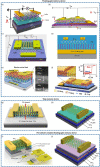Performance Limits and Advancements in Single 2D Transition Metal Dichalcogenide Transistor
- PMID: 39120835
- PMCID: PMC11315877
- DOI: 10.1007/s40820-024-01461-x
Performance Limits and Advancements in Single 2D Transition Metal Dichalcogenide Transistor
Abstract
Two-dimensional (2D) transition metal dichalcogenides (TMDs) allow for atomic-scale manipulation, challenging the conventional limitations of semiconductor materials. This capability may overcome the short-channel effect, sparking significant advancements in electronic devices that utilize 2D TMDs. Exploring the dimension and performance limits of transistors based on 2D TMDs has gained substantial importance. This review provides a comprehensive investigation into these limits of the single 2D-TMD transistor. It delves into the impacts of miniaturization, including the reduction of channel length, gate length, source/drain contact length, and dielectric thickness on transistor operation and performance. In addition, this review provides a detailed analysis of performance parameters such as source/drain contact resistance, subthreshold swing, hysteresis loop, carrier mobility, on/off ratio, and the development of p-type and single logic transistors. This review details the two logical expressions of the single 2D-TMD logic transistor, including current and voltage. It also emphasizes the role of 2D TMD-based transistors as memory devices, focusing on enhancing memory operation speed, endurance, data retention, and extinction ratio, as well as reducing energy consumption in memory devices functioning as artificial synapses. This review demonstrates the two calculating methods for dynamic energy consumption of 2D synaptic devices. This review not only summarizes the current state of the art in this field but also highlights potential future research directions and applications. It underscores the anticipated challenges, opportunities, and potential solutions in navigating the dimension and performance boundaries of 2D transistors.
Keywords: Artificial synapses; Dimension limits; Memory devices; Performance limits; Two-dimensional transistors.
© 2024. The Author(s).
Conflict of interest statement
The authors declare no interest conflict. They have no known competing financial interests or personal relationships that could have appeared to influence the work reported in this paper.
Figures

















References
-
- C. Liu, H. Chen, S. Wang, Q. Liu, Y.-G. Jiang et al., Two-dimensional materials for next-generation computing technologies. Nat. Nanotechnol. 15, 545–557 (2020). 10.1038/s41565-020-0724-3 - PubMed
-
- L. Yin, R. Cheng, J. Ding, J. Jiang, Y. Hou et al., Two-dimensional semiconductors and transistors for future integrated circuits. ACS Nano 18, 7739–7768 (2024). 10.1021/acsnano.3c10900 - PubMed
Publication types
LinkOut - more resources
Full Text Sources
